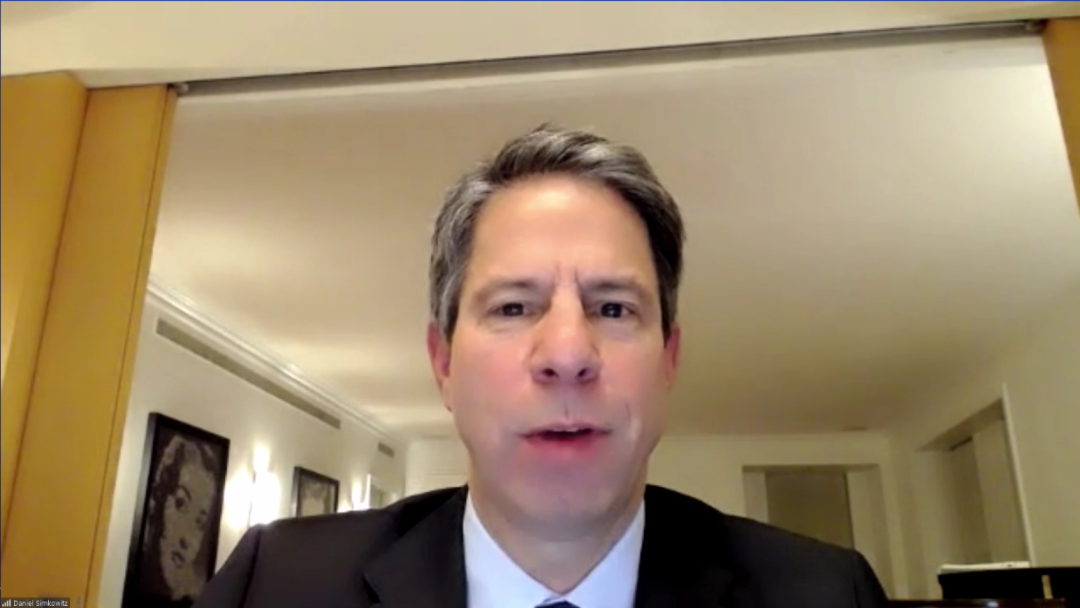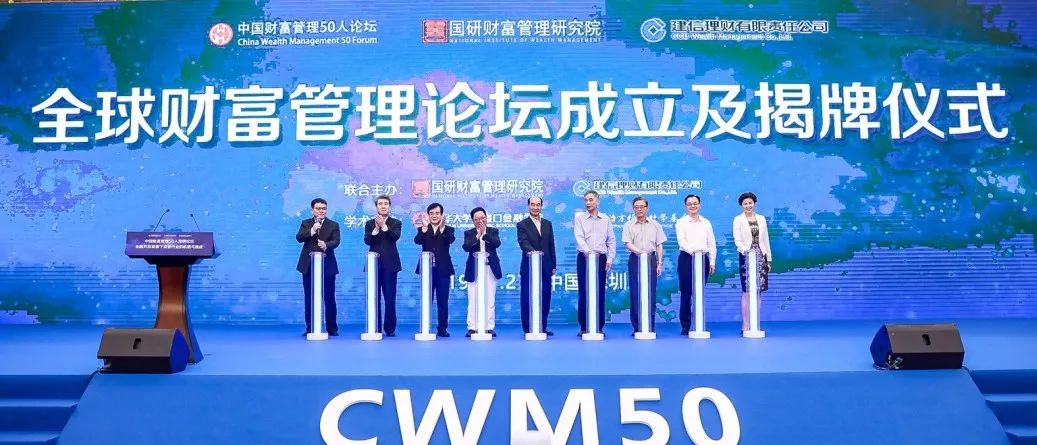摩根士丹利投资管理CEO:以可持续投资创造长期价值

摩根士丹利投资管理首席执行官丹尼尔·辛克维兹先生(Daniel Simkowitz)近日出席全球财富管理论坛上海苏河湾峰会时,就可持续投资话题发表主题演讲。作为可持续投资领域的先驱者之一,辛克维兹先生介绍了摩根士丹利对可持续投资方向所做的趋势性分析,并通过一些实践案例明确了可持续投资与量化投资策略相结合的可行性。在当前全球碳中和的大背景之下,他进一步指出可以将ESG目标作为一个创造长期价值的抓手,逐步形成全球性的可持续投资规范,以帮助投资者和企业可持续地开拓未来市场。
以下为演讲全文。

在2022年全球财富管理论坛
上海苏河湾峰会上的演讲
丹尼尔·辛克维兹
随着全球新闻头条纷纷被新冠肺炎疫情、气候变化和资源分配不均问题所占据,环伺当前海内外政治环境及经济局面,金融机构和投资者正面临越来越大的压力,期望要以负责任的方式管理甚至应对可持续性问题。早期市场上对可持续投资的怀疑已逐渐消弭,甚至许多市场参与者将可持续性视为未来投资的核心策略。
然而,尽管可持续投资增长势头迅猛且遍地开花,但要在中国和全球范围内向可持续投资实现全面转型,数据标准和量化方式的缺失仍然是不得不面对的一项挑战。摩根士丹利在推进可持续投资方面的研究以及我们在这一领域的经验表明,可持续投资已成功跻身主流投资方式,但要取得进一步的增长,我们必须解决一些更复杂的问题。
在深入探讨本主题之前,让我先简要介绍一下本公司在中国的经营历程以及我们对中国市场的作为。摩根士丹利有幸成为首批在中国大陆开展业务的国际投行。我们于1994年开设了上海办事处,自那时起,我们的目标就是在中国建立一家业内领先且业务全方位整合的金融服务公司。在朝这一目标迈进途中,我们于1995年与中国建设银行合资成立了中国国际金融有限公司,这在当时属于中国内地证券类合资企业之首创。
2008年,我们与华鑫证券合作成立了基金管理公司,即摩根士丹利华鑫基金管理有限公司,继续推动了公司的发展。截至2021年,该公司已赢得晨星中国、《中国证券报》和其他权威机构颁发的73个业界广泛认可的奖项。近年来,我们还分别成立了一家人民币私募股权投资管理公司和一家合资证券公司。
得益于过去27年的不懈努力以及与主要区域性公司的紧密合作,我们已在中国搭建了多元化的商业平台架构,业务涵盖商业银行、证券、公募基金和私募股权投资基金等。
如今,摩根士丹利除了设立在香港的亚太区总部外,还在北京、上海、杭州、深圳和珠海设有办事处,为中国的国内外客户提供广泛服务。对摩根士丹利而言,中国一直以来都是全球范围内的重要市场。在未来数年,我们将继续加大对资本、人才及基础设施的投入,同时继续拓展业务范围。
正如我们多年深耕于中国,摩根士丹利长期以来都是可持续投资领域的市场领导者,为此我们深感自豪。我们开始专注可持续投资的时间比华尔街大多数公司都要早得多。2009年,在金融危机期间,我们便成立了“全球可持续金融小组”在整个摩根士丹利集团推动可持续发展战略。当时公司就认识到,可持续投资对我们的客户来说将是一个愈发重要的主题,也是体现摩根士丹利差异化特征的一个关键。
起初,我们经常会遭到质疑,即追求利润的投资者应不应该或会不会对这个领域感兴趣。当时摩根士丹利甚至是整个金融行业都需要说服持怀疑态度的投资者,为社会和环境影响做可持续投资并不一定意味着收益会折损。分析可持续投资的绩效并证明其韧性,对于推进该领域向前发展至关重要,这也有助于鼓励更多人采用ESG理念进行投资。
摩根士丹利可持续投资研究所的研究报告《可持续发展现状》显示,在2020年,美国可持续股票基金的业绩表现超出传统同类基金百分比的中位值4.3个百分点,这是自2004年以来的最大业绩差异,并且是在全球疫情肆虐下这一充满不确定性的年份收获的结果。研究进一步凸显了可持续基金在风险调整后获得更高回报的潜力,特别是在市场剧烈波动的时期。
根据该研究数据,全球专业管理的可持续资产超过35万亿美元,占全球资产管理总额的三分之一以上。到2025年,全球可持续资产有望超过53万亿美元。
此外,第26届联合国气候变化大会还告诉我们,要在2050年前实现碳中和排放的目标,需要进行数额高达100~150万亿美元的投资(根据碳中和排放银行业联盟的预估),这意味着2021~2025年的年度投资额必须是前一个五年期的三倍,达到每年2.6万亿美元。
摩根士丹利在中国的基金管理合资公司,摩根士丹利华鑫基金,于2018年就率先在中国市场开展ESG投资研究。我们参加了中国证券投资基金业协会举办的ESG研讨会,并参与起草了《绿色投资指引》和《上市公司ESG投资指引》。同年,我们开始开发名为“ESG DataLAB”的ESG智能投资研究平台,以解决A股上市公司在社会责任方面披露有限等问题。2019年,我们成为中国第八家签署《联合国负责任投资原则》的公募基金管理公司。2020年7月,摩根士丹利华鑫基金管理有限公司成立了首支由ESG DataLAB提供支持并结合可持续投资策略与量化投资策略的ESG主题基金,开创了可持续投资与量化投资策略相结合的先河。
然而,尽管可持续投资如今已稳稳跻身主流,但我们的研究发现,许多资产所有者都很难自己制定一个成功的长期可持续投资策略。在投资理念多样化、利益相关方面临多重压力以及监管力度不断加大的快速变化背景下,各种问题层出不穷。最常见的包括:实施可持续投资共有多少种方法?我们应该如何定义和表达成功?我们的主要利益相关方是谁?从哪儿切入我们的投资组合最好?
在过去十年中,摩根士丹利投资管理和摩根士丹利可持续投资研究所与世界各地的资产所有者合作,定义并推进其可持续投资计划。在合作的过程中,我们了解到,构建成功的可持续投资策略是复杂的,而且必须量体裁衣。
全球资产所有者现在通常会将ESG因素纳入其投资决策。在我们2020年对全球资产所有者进行的调查中,80%的资产所有者积极地将ESG因素纳入投资流程,这一比例在两年内上升了10个百分点,另有15%的资产所有者正在考虑这样做。95%的资产所有者正在将可持续投资融入或考虑融入其全部或部分投资组合。88%的资产所有者希望通过主题投资在全球范围内产生积极影响。
然而该研究发现,资产所有者面临验证其投资的道德、环境和社会属性的压力。投资者寻求更优的工具和数据来衡量可持续性。事实上,资产所有者迫切希望量化并公告投资组合的社会影响,但近三分之一的资产所有者缺乏基于其ESG目标评估投资的适当工具。大多数投资者还认为,与ESG目标言行一致的公司可以成为更好的长期投资标的,但仍然需要更合适的报告及数据原则来评估持股比重。
当投资者专注于定义自己的ESG目标和战略的时候,另一个能够支撑ESG市场增长的关键因素则是围绕ESG建立的全球规范。Calvert是摩根士丹利投资管理旗下专注于ESG投资的业务公司,也是美国最大的责任投资公司之一,该公司的研究进一步证明了更多标准化工具和量化能力对投资者十分重要。Calvert指出了《联合国可持续发展目标》、《联合国责任投资原则》和《巴黎气候协定》等协定中所表达的全球规范的重要性。这些全球规范作为一个框架,可以帮助投资者和企业创造一个更可持续的世界。这些努力的关键之处在于需要有一套稳健的机制,让企业参与重大的ESG问题,相较以往,这一点便成了当务之急。
目前,投资者通过一系列非标准化来源,如公司网站、企业社会责任报告、可持续性报告、公司监管备案文件或简单预估,来获取有关公司碳排放披露、人力资本和多样性的信息。然而,世界各地的政府监管机构都表示,将开始或提前要求公司披露碳排放、人力资本和部分多样性数据。新环境需要更高质量的数据,这将增加对ESG专业分析的需求,以便将信息反映在证券价格中。
一个潜在的好处是,那些在ESG方面管理实践水平高的公司,以及最早寻求在碳排放、人力资本和多样性方面降低风险敞口的投资者们,其相应的业绩预期会得到显著提高。
可持续投资的业绩驱动因素是业内经常谈论到的话题,因为越来越多的证据表明,可持续性或将带来长期的价值创造。各类利益相关方将继续朝这个方向发力,譬如养老金希望降低其投资的ESG风险,或千禧一代希望通过他们的资本产生积极的社会影响,抑或监管机构要求提高信息披露和透明度。随着人们对可持续投资的需求加速增长,我们认为科技和第三方投资管理公司在可持续性的量化以及进一步推动可持续投资策略方面将发挥关键作用。随着业内相应工具的开发而推动可持续投资策略发展,诸如摩根士丹利这样的公司将更好地服务于客户及其利益相关方。

Speech at GAMF 2022 Shanghai Summit
Daniel Simkowitz
With the COVID-19 pandemic, climate change and inequality collectively driving news headlines, political discourse and economic realities around the globe, financial services firms and investors are facing increased pressure to responsibly manage, and even address, sustainability issues. Any early skepticism in sustainable investing has been replaced by a strong inclination and many market participants see sustainability as core to the future of investing.
However, despite rapid momentum and widespread adoption, challenges including lack of standardization in data and measurement continue to be a challenge to navigating a more comprehensive transition to sustainable investing both in China and globally. Morgan Stanley’s research into adoption of sustainable investing and our own experience in this space reveals how sustainable investing has gathered enough momentum to reach the mainstream yet has a distinct complexity that must be addressed for further growth.
Before I dive into the topic, let me begin with a brief background on our firm’s long history in China and commitment to the region. Morgan Stanley is proud to have been one of the first global investment banks to establish a presence in China. We opened our Shanghai office in 1994 with a goal of building a leading, fully integrated financial services firm in China. We made progress towards that goal by founding China International Capital Corporation with the China Construction Bank, the first securities joint venture of its kind, in 1995.
We continued our growth in 2008 partnering with Huaxin Securities to form a fund management company, Morgan Stanley Huaxin Fund Management Company. As of 2021, this business has won 73 prestigious awards by Morning Star China, China Securities Journal and other authorities. In more recent years, we have also established a RMB private equity investment management firm and a securities joint venture.
As a result of these efforts and in strong partnership with key regional firms over the past 27 years, we have developed a diversified onshore business platform in China that includes securities, a commercial bank, mutual funds, and private equity funds.
Today, Morgan Stanley has offices in Beijing, Shanghai, Hangzhou, Shenzhen and Zhuhai in addition to our regional headquarters in Hong Kong and we are able to provide a wide range of services to domestic and international clients in China. China remains a critical market for Morgan Stanley globally and over the coming years we will continue to invest capital, and in our talent and infrastructure, as we continue to expand our business footprint.
As with our substantial history in China, we also proud to have long been a market leader in sustainability. We began our focus on sustainable investing much earlier than most of Wall Street. In 2009, during the financial crisis, we launched a Global Sustainable Finance group to drive our sustainability strategy across Morgan Stanley. The firm recognized that this would be a topic of increasing importance to our clients and a key differentiator for Morgan Stanley.
In the beginning, we often received skepticism as to if this was an area that profit seeking investors should or would be interested in. Both Morgan Stanley and the industry more broadly had to convince skeptical investors that investing for social and environmental impact does not necessarily entail financial sacrifice. Analyzing the performance of sustainable investments, and proving their resiliency, has been critical to advancing the field and encouraging others to invest with an ESG mindset.
According to Sustainable Realities, a study by the Morgan Stanley Institute for Sustainable Investing, U.S. sustainable equity funds outperformed traditional peer funds by a median of 4.3 percentage points in 2020, the largest difference in performance recorded since 2004, in a year marked by uncertainty amid the global pandemic. The results of the study further highlight the potential for better risk-adjusted returns from sustainable funds, especially in times of severe market volatility.
It should be no surprise that there’s more than $35 trillion of sustainable assets under professional management globally which represent more than 1/3 of global AUM. Global assets are on track to exceed $53 trillion by 2025.
In addition, COP26 taught us that reaching the target of net-zero carbon emissions by 2050 calls for a staggering $100~150 trillion in investments (per Net-Zero Banking Alliance estimates), meaning annual investments must jump threefold to $2.6 trillion in 2021~2025 versus the prior five-year period.
Within Morgan Stanley Huaxin Fund Management, our China fund management joint venture, we started ESG investment and research back in 2018 ahead of many of our peers. We participated in ESG seminars organized by AMAC and took part in drafting the "Green Investment Guidelines" and the "ESG Investment Guidelines for Listed Companies". In the same year, we embarked on the development of our proprietary ESG intelligent investment research platform called ESG DataLAB to overcome issues such as limited disclosure of social responsibility reports by A-share listed companies. In 2019, we joined UNPRI and were the eighth mutual fund management company in China to do so. In July 2020, Morgan Stanley Huaxin Fund Management established an ESG-themed fund. This product is supported by ESG DataLAB, while pioneering the combination of sustainable investment and quantitative investment strategies.
Yet, while sustainable investing is now firmly in the mainstream, our research has found that many asset owners struggle to formulate a successful long-term strategy for their institution. Against a fast-moving backdrop of varied investment philosophies, wide-ranging stakeholder pressure and growing regulation, a host of questions often emerge. Among the most common: What is the full spectrum of approaches to sustainable investing implementation? How should we define and communicate success? Who are our key stakeholders? Where is the right place to start within our investment portfolio?
Over the past decade, Morgan Stanley Investment Management and the Morgan Stanley Institute for Sustainable Investing have collaborated with asset owners from around the world to define and advance their sustainable investing programs. Through this process, we have learned that constructing a successful sustainable investing strategy is complex, and one size does not fit all.
Global asset owners now routinely incorporate environmental, social and governance (ESG) factors in their investment decision making. In our 2020 survey of global asset owners, eight in ten asset owners actively integrate ESG factors into the investment process, up 10 percentage points in two years, while a further 15% are considering doing so. 95% are integrating or considering integrating sustainable investing in all or part of their portfolios. 88% want to drive impact at the global level through their thematic investments.
However, the study found that asset owners face pressure to demonstrate the ethical, environmental and social attributes of their investments. Investors seek better tools and data to measure sustainability. In fact, asset owners are eager to measure and report portfolio impacts, but nearly a third lack adequate tools to assess investments against their ESG goals. The majority of investors also believe that companies with ESG-aligned practices can be better long-term investments but continue to need better reporting and data to evaluate holdings on those criteria.
As investors focus on defining their ESG goals and strategies, another key factor that could support the growth of the ESG market would be global norms around ESG data. Research from Calvert, our ESG-focused investment business and one of the largest responsible investment companies in the United States, further supports the importance of more standard tools and measurement capabilities for investors. Calvert identified the importance of global norms, expressed in agreements such as the United Nations Sustainable Development Goals, United Nations Principles for Responsible Investment (UNPRI) and the Paris Climate Accord. These global norms can provide a framework for investors and businesses to create a more sustainable world. Critical to those efforts is a robust program for engaging corporations on material ESG issues, which is more essential now than ever before.
Currently, investors receive information about companies’ carbon exposure, human capital and diversity information from a range of non-standardized sources, such as company websites, corporate social responsibility reports, sustainability reports, company regulatory filings or simple estimates. However, government regulators around the world have indicated they will begin or advance requirements for the disclosure of carbon, human capital and some diversity data. A new environment of higher quality data will increase the need for expert ESG analysis to incorporate the information into securities prices.
One potential outcome is enhanced performance expectations for those companies with strong ESG management practices and investors initially seeking lower risk exposures across carbon, human capital and diversity.
Financial drivers of sustainable investing are regularly entering investment conversations, as the growing pool of evidence demonstrates that sustainability may support long-term value creation. And stakeholders of all kinds will continue to push for action, from pensioners seeking to mitigate ESG risks or Millennials looking to achieve positive impact through their capital as well as to regulators requiring greater disclosure and transparency. As the appetite for sustainable investing rapidly accelerates, we see technology and third-party investment managers playing a key role in measuring sustainability and further driving adoption. Firms like Morgan Stanley can play a critical role supporting clients and other stakeholders as the industry develops the necessary tools to drive even further adoption.
全球财富管理论坛

全球财富管理论坛是在金融开放背景下,为顺应全球资产管理行业发展与中国资产管理行业转型需求,由清华大学经济管理学院、孙冶方经济科学基金会、中国财富管理50人论坛联合发起成立的一个国际性交流平台组织,论坛旨在构建一个汇聚全球资产拥有者和管理者、监管部门和市场代表的长期对话沟通平台,为国内外资产管理机构搭建交流与合作的桥梁。

